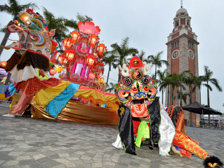
Propitious moves:
Qilin dancing is arranged at festivals as a celestial blessing, to bring peace, luck, protection, success and longevity to festival goers.
Propitious moves:
Qilin dancing is arranged at festivals as a celestial blessing, to bring peace, luck, protection, success and longevity to festival goers.
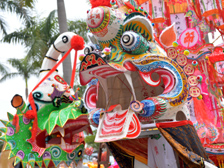
Lucky charms:
The Hakka qilin has eight symbols known as trigrams on its horn, and cow-like ears. Symbols of wealth and good fortune, such as gold coins and a peony, are drawn on its face.
Lucky charms:
The Hakka qilin has eight symbols known as trigrams on its horn, and cow-like ears. Symbols of wealth and good fortune, such as gold coins and a peony, are drawn on its face.
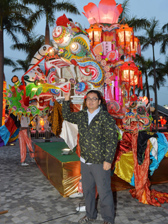
Home made:
Local paper-crafting master Kenneth Mo stresses that all his paper masterpieces are crafted in Hong Kong.
Home made:
Local paper-crafting master Kenneth Mo stresses that all his paper masterpieces are crafted in Hong Kong.
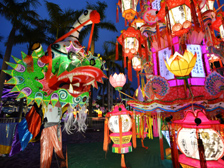
Oversized artworks:
Master Mo has much experience making giant lanterns, but this was the first time he created gigantic qilins.
Oversized artworks:
Master Mo has much experience making giant lanterns, but this was the first time he created gigantic qilins.
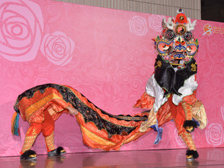
Cavorting creature:
Qilin dance movements are characterised by fast, powerful strokes of the head, with an emphasis on criss-cross steps and swift turns of the body at a low level.
Cavorting creature:
Qilin dance movements are characterised by fast, powerful strokes of the head, with an emphasis on criss-cross steps and swift turns of the body at a low level.
Lanterns set benevolent qilin aglow
February 16, 2014
The enchanting creature known as the Chinese unicorn, or qilin, is one of the four benevolent animals in Chinese culture, along with the dragon, tortoise and phoenix. Anyone who’s ever been to China, or a Chinatown, is likely to be familiar with lion dancing, but qilin dancing is more low key. Some New Territories villagers keep this tradition alive during festivals, celebrations or weddings.
Qilin dancing was recently recognised as being part of Hong Kong’s intangible cultural heritage. To raise its profile, the Hong Kong Heritage Museum commissioned local paper-crafting master Kenneth Mo to create three qilin figure sets and a three-meter-high lantern, now on display at the Lantern Carnival at the Hong Kong Cultural Centre Piazza until February 23.
Mo grew up in Kwu Tong Village in Sheung Shui, where he was introduced to qilin at an early age. He grew fond of the tradition, and followed a master to learn qilin dancing at the age of 19. When his master asked him to learn to repair the worn out qilin head crafted from paper, he took up that art under another master’s tutelage. Practice makes perfect, and after more than two decades, he has mastered the paper-crafting art.
Colourful craft
The three sets of qilin dancing figures he created reflect different regional styles - Hakka, Dongguan and Hailufeng. They share bold colours, but each has easily recognisable, stand-out features on their heads.
The Hakka qilin has eight symbols known as trigrams on its horn, and cow-like ears. Symbols of wealth and good fortune, such as gold coins and a peony, are drawn on its face.
The Dongguan qilin’s key colours are red and green, with drawings of a phoenix and carp on its head. The Hailufeng qilin has a green face and a white horn that is much bigger than that of the other two. It is curved and prominent, with the image of the Eight Immortals drawn on its forehead.
Oversized artworks
The project’s size was daunting: Mo took nearly three months to finish the works, with each qilin figure set standing about four meters high and four meters in length - twice the size of a normal set used for dancing.
“This was the first time I had created such a big paper-crafted qilin, so the difficulty was to ensure the enlarged qilin figures had the same look as the original sized ones that we normally see in the qilin dance,” Mo said.
His paper crafted products are all made in Hong Kong, he stresses.
“I believe the traditions of qilin dancing and paper-crafting techniques will not disappear in Hong Kong. But it will require the people in this field to continue to work hard and devote themselves, regardless of poor pay and reward. I will continue working until one day I can’t anymore.”
Fertility symbol
Chinese legend says a qilin appears at the birth of a sage, and that one materialised at the birth of renowned Chinese teacher and philosopher Confucius. The legendary creature is also a symbol of fertility, and believed to be able to bring a baby boy to a family. Little wonder Hakka people will arrange a qilin dance on the wedding day when the bridegroom visits the bride’s home and brings her back to his.
Qilin dancing is arranged at festivals as a celestial blessing, to bring peace, luck, protection, success and longevity to festival goers. Two performers control the qilin’s head and body. Unlike lion dancing, qilin dance movements are characterised by fast, powerful strokes of the head, with an emphasis on criss-cross steps and swift turns of the body at a low level. There are no high jumps to circular platforms raised on poles.
Qilin dancing has been inscribed onto China’s national list of intangible cultural heritage. It is now included in the draft inventory of Hong Kong’s intangible cultural heritage, organised by the Leisure & Cultural Services Department.